#satsuma rebellion
Text
Flag of the Republic of Ezo

This is the flag of the Republic of Ezo. It comes from a world where the Boshin War went slightly more favorably for the Shogunate forces. As a result, the Meiji government was forced to, at least temporarily, recognize the Republic of Ezo. It wasn't long before the Japanese declared war on Ezo once again. However, the Satsuma Rebellion still happened and was a lot more widespread, emboldened by Ezo's success. The Meiji government was forced to focus on quelling the Satsuma Rebellion. Ezo was able to find support from France and Russia to help protect them from the Japanese. Eventually, Japan had no choice but to formally recognize the Ezo government.
In response to Ezo's alliance with France and Russia, Japan strengthened its ties to Britain and Germany. Following their failure to capture Hokkaido, the Japanese turned their attention to Korea. Ezo, under the command of the recently defected Saigo Takamori, also sent an expedition to conquer Korea. Korea was able to play Japan and Ezo off of each other, and was able to maintain its independence. In time, Korea was able to modernize and industrialize like Japan had. Japan was humbled by its failure in Korea, and the Japanese were forced to focus more on domestic policy than foreign conquest.
Ezo also pursued a policy of isolationism following the failed expedition to Korea. Some industrialization was a necessary evil, but on the whole Ezo strived to maintain as much of its traditional culture and way of life as possible. As time went on, however, Ezo began to increasingly fall under French influence. In many way, it could be said that Ezo had become a French protectorate.
World War I started off around the same time, and with very similar circumstances, as our world. However, in this world Japan fought for the Central Powers. The Japanese were bitter at the British for selling weapons to Ezo, resentful growing opposition to the creeping British influence on Japanese society, and their alliance with Germany was as strong as ever. Ezo initially tried to remain neutral, but a surprise Japanese attack prompted Ezo to join the Entente Powers. The war ended in an Entente victory. Japan was placed under crushing reparations to Ezo, and was forced to cease land in northern Japan to Ezo.
Japan began to grow resentful against Ezo, and began to rearm for another war. Ezo and Korea were subjected to a series of harsh bombing campaigns. It wasn't long before Ezo and Korea were forced to surrender and formerly occupied by Japan. The Japanese continued to expand their influence across East Asia and the Pacific. It wasn't long, however, before they found themselves in conflict with the United States. Like in our world, the war ended in an American victory.
Ezo regained its independence following the war. Though there is still bad blood between Ezo and Japan, the two nations are slowly putting their past behind them. There is a movement to reunify Ezo and Japan into a single nation, but it doesn't have much support at the moment. Still, you never know what the future might hold.
The flag is black and white in reference to the flag of the Tokugawa Shogunate, and the seven-pointed star stands for the spirit of the Ezo people.
Link to the original flag on my blog: https://drakoniandgriffalco.blogspot.com/2017/10/flag-of-republic-of-ezo.html?m=1
#alternate history#alternate history flag#alternate history flags#alt history#vexillology#flags#flag#Japan#Ezo#Hokkaido#Republic of Ezo#Flag of the Republic of Ezo#Satsuma Rebellion#Boshin War#Samurai#Shogunate#meiji restoration#Saigo Takamori
17 notes
·
View notes
Text
5 Trivia about The Last Samurai
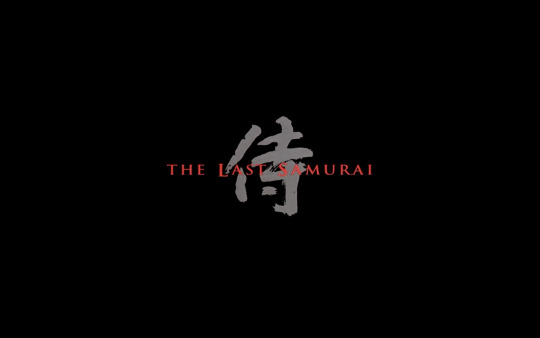
Although The Last Samurai is known to be historically inaccurate, I realized that some part of it does make sense but the producers just tried to simplify it for the audience as not everyone knows the complex history of Japan.
1. Katsumoto and Hasegawa

They fought together for the Emperor but now they fight on opposing sides.

Katsumoto 's character is based on Saigo Takamori of Satsuma .

Hasegawa is probably inspired by Hasegawa Yoshimichi of Choshu .
Historically, Satsuma once supported the Shogunate (Shogun) while Choshu supported the Imperial (Emperor). But over time Satsuma realized the urgency of change and embrace new technology in the face of emerging Western Powers and that the decaying and stubborn Shogunate will destroy the country .
Satsuma join forces with Choshu to overthrow the Shogunate. After they succeeded, Satsuma realized they got played as the new Imperial government is dominated by Choshu instead of having lords from various clans to govern the country and retaining the Samurai way of life but with modern technology .
This sparks the Satsuma Rebellion against the Imperial (Emperor) where former Samurai rallied to Saigo Takamori. While the Imperial is fully modernized and equipped with guns and canons, Satsuma has limited supplies by then and the Ronin that rallied to the cause are poor and uses Katana and arrows.
2. Guns and Samurai

So yes, guns are available since the time of Oda Nobunaga who changed the way of war in Japan and the number of guns used in battle increases as time goes by so one would think that by the time The Last Samurai takes place everyone should have guns right?
While the movie showed Katsumoto as a man of principles to not use modern weapons but there is a practical reason : money. After the collapse of the Shogunate, the Imperial strip the Samurai of their lands, earnings and status, so they became poor and could not afford to buy more guns.
Guns are not cheap, especially when there is high demand for the European traders to make profit. A reason why in the early days, some Kyushu lords convert to Christianity. Not out of faith but to get exclusive deals of cheap new guns in exchange of allowing the priests into their domains to preach.
3. Poor Samurai
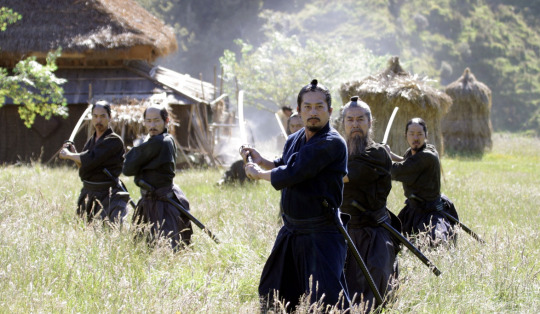
Where is Katsumoto's castle? Every Daimyo has his own castle. As mentioned, since the Samurai are stripped of their lands, the Castles are now under the control of the Imperial. So Katsumoto withdrew to the mountains of his ancestral place at his son’s village, where the monks and peasants are.
Here he reflected his past actions, probably regretting what he had done and seen at Aizu. While the Satsuma are reasonable but the Choshu are less forgiving due to their personal grudges with the Tokugawa Shogunate that strip away their lands and dignity after their defeat at Sekigahara .
In the Japanese Drama, Yae No Sakura , when the Imperials entered Aizu, the Satsuma was shocked to find most of the defenders are women and children who committed seppuku to avoid capture, lying dead all over Aizu, which disturbed the commander who was expecting Samurai and foot soldiers.
I like to think this commander is Katsumoto which is why he understands what Algren was feeling knowing that they both do not deserve to live.
4.The European Samurai
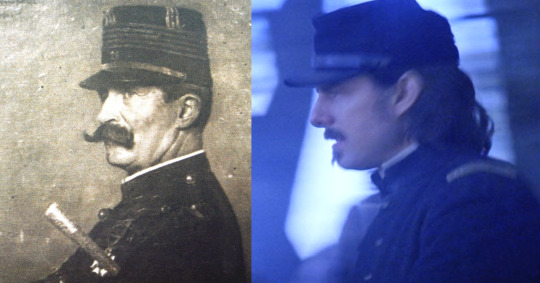
Nathan Algren is based on Jules Brunet of the French military who was sent to Japan by Napoleon III to train the Japanese in modern weaponry. He was caught in the crossfire when the Boshin War broke out and received orders to return home to France but he rejected it to stay and fight with the Samurai.
He trained the Aizu Samurai and develop comradeship with them, particularly with the Vice Commander of the Shinsengumi , Hijikata Toshizo . Although Jules Brunet did not wear Samurai armor but he did fought alongside them till the end until the death of Hiijikata at Hokkaido when they were outnumbered.
But Jules Brunet managed to return safely to France just as Nathan Algren survived the war. And just as Nathan Algren talked to the Emperor about how Katsumoto lived his life as a Samurai, Jules Brunet wrote in his memoir, holding Hiijikata Toshizo in high regard , referring to him as the last true Samurai.
5. English Speaking Samurai
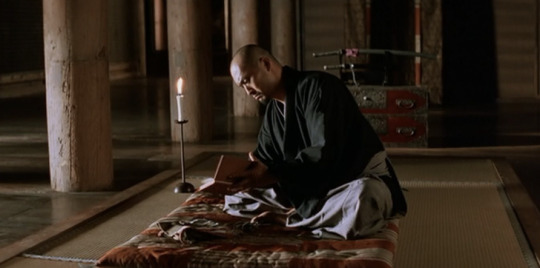
Since the arrival of the Europeans and Black Ships, the Samurai have been studying in earnest about Western medicine and technology, hoping to elevate their standing on the world platform and be an equal to the European powers as they fear of what happened to China in Opium Wars happen to them next.
Not all, but the high ranking Samurai, especially those on the West of Japan like the Satsuma and Choshu who have been trading with Europeans for many years and have begun learning their languages so it is of no surprise that Katsumoto knows English which he teaches his son as well.
Besides, unlike the early days of the Samurai, during the 300 years of peace and isolation under Tokugawa Shogunate, the Samurai learn to read and write in order to help the Shogun administer and govern the country including land surveying, tax collecting and accounting balance sheets .
Thoughts

Overall I think the producers did an amazing job simplifying the long and complex history of Boshin War and Meiji Restoration in a span of two hours plus movie without exaggerating. For a historical fiction I think it's pretty great. After all it'a not a documentary but a masterpiece meant to be enjoyed, filled with spirituality and life lessons.
But that is a story for another time. Thank you for reading.
youtube
#the last samurai#ken watanabe#tom cruise#boshin war#meiji restoration#satsuma rebellion#japan#japanese history#samurai#saigo takamori#jules brunet#hiijikata toshizo#shinsengumi#yae no sakura#oda nobunaga#sekigahara#opium war
44 notes
·
View notes
Text
日本の歴史366 Day 46
2月15日 Summary:
The Satsuma Rebellion was a revolt of dissatisfied and disgruntled samurai against the new government of the Meiji Restoration. The samurai didn't like the changes that the new imperial government were implementing. This rebellion was led by Saigo Takamori (who is often noted as the last samurai, as well as one of the Three Great Nobles of the Meiji Restoration). Ultimately, the rebellion ended with the ending of the samurai class
Vocab beneath the break:
西南戦争 せいなんせんそう Satsuma Rebellion (1877)
起きる おきる to occur (usu. of unfavourable incidents); to happen; to take place
敵 てき opponent; rival; adversary; enemy
つらい tough; difficult; hard (usu. of situations); difficult (emotionally); painful
ごわす to be (Kyoto dialect)
社会 しゃかい society
しくみ structure; construction; arrangement; contrivance; mechanism; workings
変える かえる to change; to alter; to transform; to convert; to turn; to vary; to reform; to revise
明治維新 めいじいしん Meiji Restoration (1868)
きっかけ chance; start; cue; excuse; motive; impetus; occasion
武士 ぶし samurai; warrior
不満 ふまん dissatisfaction; discontent; displeasure; complaint; unhappiness
たまる to collect; to gather; to save; to accumulate; to pile up
西鄕隆盛 さいごうたかもり Saigo Takamori (influential samurai, considered one of the Three Great Nobles of the Meiji Restoration) [x]
中心 ちゅうしん center; middle; heart; core; focus; pivot; emphasis; balance
反乱 はんらん insurrection; mutiny; rebellion; revolt; uprising
発生 はっせい occurrence; incidence; outbreak; birth (e.g. of civilization)
戦 いくさ war; battle; campaign; fight; troops; forces
避ける さける to avoid (situation)
敗れる やぶれる to be defeated; to be beaten; to be unsuccessful; to lose
城山 しろやま Mount Shiroyama
自ら みずから oneself; for oneself; personally; in person
命を絶つ いのちをたつ to end one's life; to commit suicide; to end a life; to kill
薩摩 さつま Satsuma (former province located in the west of present-day Kagoshima Prefecture)
政府 せいふ government; administration; ministry
戦い たたかい battle; war; fight; conflict
起こる おこる to occur; to happen
倒す たおす to overthrow; to defeat
どうやら possibly; apparently; (seem) likely; seemingly
おいどん I; me (Kagoshima dialect)
急に きゅうに swiftly; rapidly; quickly; immediately; hastily; hurriedly; suddenly; abruptly
爆発 ばくはつ outburst (of emotion); explosion (e.g. of anger); eruption (e.g. of discontent)
とともに together with; as X, then Y (e.g. as we age we gain wisdom, as wine matures it becomes more valuable, etc.)
同士 どうし fellow; mutual; companion; comrade
戦う たたかう to make war (on); to wage war (against); to go to war (with); to fight (with); to do battle (against); to struggle (against)
#shay's taking notes#japanese history 366#japanese language#japanese history#learn japanese#japanese culture#japanese grammar#japanese figures#vocab#study japanese#langblr#studyblr#satsuma rebellion#japanese#japanese langblr#jpnstudynet#history
12 notes
·
View notes
Text
Saigo Takamori and the Seinan War
ew item:

Shelf: 210.627 WIL
Ichi gaikokujin no mita Saigō Takamori to Seinan Sensō = Saigo Takamori and the Seinan war.
manga by Alice Physh ; based on the work by Sean Michael Wilson ; translated by Tashiro Yukiko ; supervised by Fukai Yumiko.
Tōkyō : Kōdansha, 2018.
ISBN: 9784065115039
109 pages : illustrations, maps ; 19 cm.
(Kodansha bilingual comics).
Parallel text in English and Japanese.
0 notes
Text
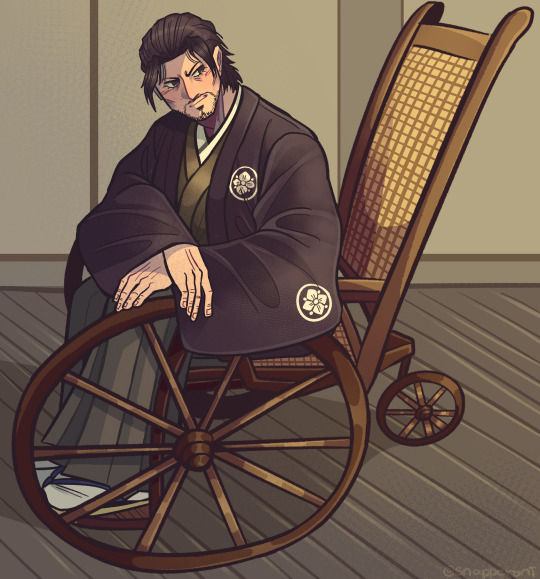
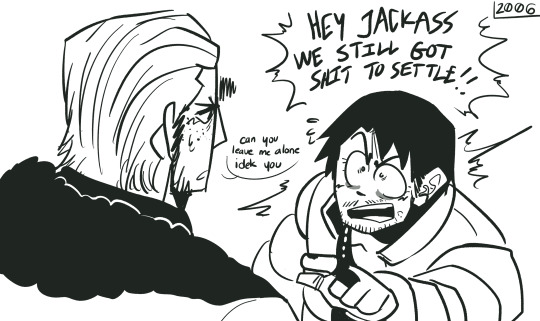

#rgg#ryu ga gotoku#yakuza series#ryu ga gotoku ishin#like a dragon: ishin!#yakuza 2#masato arakawa#daigo dojima#ryuji goda#yoshinobu tokugawa#saigo kichinosuke#rintaro katsu#snap sketches#shoving him back in the chair HE DIDNT NEED TO STAND AT ALL IN ISHIN#trying to find chairs from the 1860s made me want to scream cause theres just so much and so many varieties#in any case i just . needed to draw him in a chair#also needed to legally inject a history joke#whats so funny is that like not even like ten years later saigo takamori would get himself killed in the satsuma rebellion#which was a result of the charter oath essentially nullifying samurai 💀💀 lmao 💀💀#it's funny in the moment tho. for every reason ever#i love using my education#this why daigo got such heavy beef with ryuji down the line#ok im gona. move on with my day#i had the drawing sketched last night and just wanted to finish it before doin comm stuff but i spent my whole mornin with these 💀#k byebye
145 notes
·
View notes
Text
Imagine being a rebellious samurai in the Satsuma Rebellion and you’re all out of ammo so time to make a last stand with just your katana which is perfect because it’s close combat and then you just get ganked by some conscript that stuck a spike into his gun that’d be so embarrassing
168 notes
·
View notes
Photo
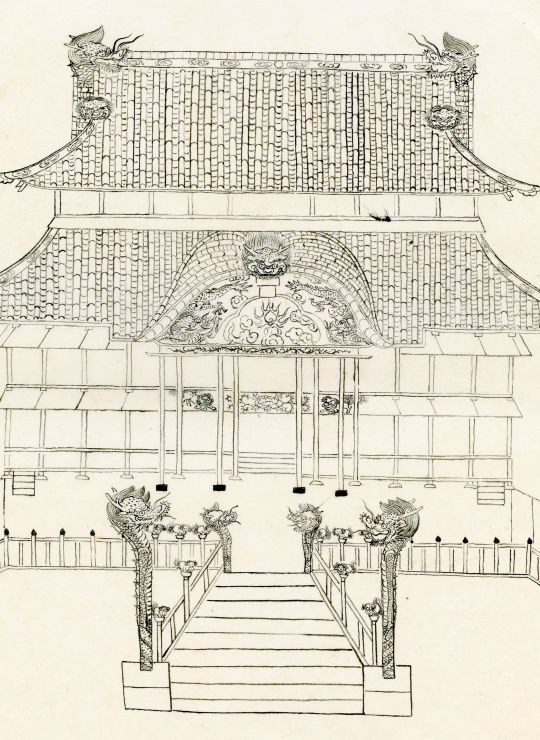
Shuri Castle - Burning castle of the Ryukyu Dynasty (Ref)
Shuri Castle, the royal castle of the Ryukyu Dynasty, was once the political, economic and cultural centre of that maritime kingdom. The date of construction of Shuri Castle is not known, but it is thought to have been built in the late 13th and 14th centuries during the Gusuku period.
Until the end of the 16th century, the Ryukyu Kingdom remained independent in turbulent East Asia, as did Korea and Vietnam, but was invaded and ruled by the Satsuma clan (now Kyusyu, Japan), and became a vassal state in the early 17th century.
After several fires and war damage, and repeated rebuilding, the World Heritage Site Shuri Castle was once again destroyed by a sudden fire on 31 October 2019, which lasted about eight hours and destroyed nine buildings and historical heritage sites, including the main hall. It is currently being rebuilt with a view to restoration in 2026.
The first burning occurred in 1453 during the struggle for the throne that followed the death of King Shō Kinpuku of the 1st Shō dynasty (Shiro-Furi Rebellion), when the castle was completely destroyed. The second fire, in 1660, took 11 years to rebuild, and the third fire in 1709 destroyed the main, north and south halls.
After the Ryukyu Disposition following the establishment of Okinawa Pref. by Japanese Government in 1879, the main hall and other buildings of Shuri Castle lost their role as the seat of government and were sold to the Japanese Army's 6th Division (Kumamoto, Japan) as a military camp and then to Shuri Ward (later Shuri City), which used them as school buildings for girls' schools.
It was almost completely destroyed during the Battle of Okinawa (WWⅡ) in 1945 and the construction of the University after the war, leaving only a small portion of the castle walls and building foundations remaining.
Full-scale reconstruction was considered in the 1980s, and the restoration work, which took about 40 years, was completed in January 2019. In October of the same year, a mysterious fire destroyed the castle again.
Shuri Castle, which has been repeatedly persecuted and burnt down but continues to revive, seems to symbolise Ryukyuan culture itself.
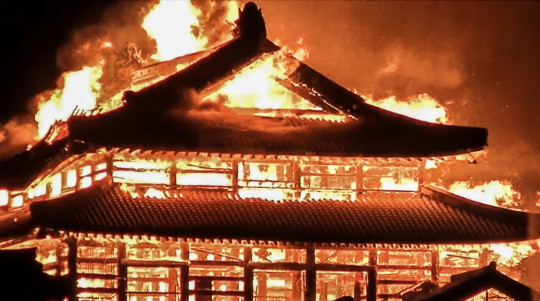
首里城 〜 燃え続ける琉球王朝のお城(参照)
琉球王朝の王城、首里城はかつてその海洋王国の政治・経済・文化の中心にあった。首里城の築城年代は明らかではないが、13世紀後半から14世紀にかけてのグスク造営期の時代に築城されたと考えられている。
琉球王国は16世紀末まで、朝鮮やベトナムと同様に激動の東アジアで独立を保っていたが、薩摩藩 (現在の九州)の侵略と支配を受け、17世紀初頭に属国となった。
世界遺産でもある首里城は、数度の火災や戦災を経て、再建を繰り返してきたが、ついに2019年10月31日、約8時間にわたる突然の火災により、本殿を含む9つの建物や歴史遺産を焼失した。現在、2026年の復興に向け、再建中である。
1度目の焼失は1453年に第一尚氏の尚金福王の死後に発生した王位争い (志魯・布里の乱) であり、城内は完全に破壊された。2度目の焼失は1660年のことであり再建に11年の年月を要した。1709年には3度目の火災が起き正殿・北殿・南殿などが焼失した。
1879年の日本政府による沖縄県設置に至る琉球処分以後は、正殿など首里城の建物は政府の所在地としての役割を喪失し、日本陸軍の第6師団 (熊本) の軍営として、その後は首里区 (後の首里市) に払い下げられ、女学校の校舎として利用された。
1945年の沖縄戦や戦後の琉球大学建設でほぼ全壊し、城壁や建物の基礎の一部が残るのみであった。1980年代に本格的な再建が検討され、約40年の歳月をかけた修復工事が2019年1月に完了した。同年10月、謎の大火災により再び焼失した。
迫害や焼失を繰り返しながらも復活を続ける首里城は、琉球文化そのものを象徴しているようだ。
102 notes
·
View notes
Photo
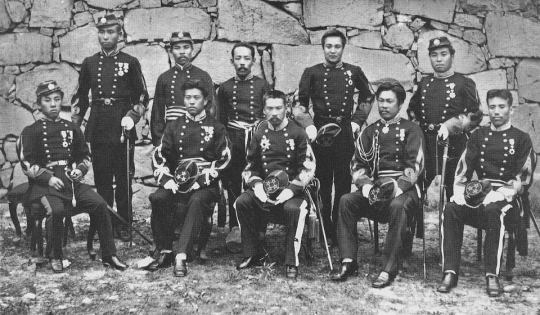
Imperial Japanese officers stationed at Kumamoto Castle during the Satsuma rebellion, 1877
87 notes
·
View notes
Note
Between Shinbei, Gensai, Hanjiro, and Izo, who was the most skilled in scowrdmanshio between the four?
That's a really difficult question to answer.
Each of these men were skilled swordsmen in their own right, and outside of seeing them go up against one another, it's a difficult judgment to make.
Nakamura Hanjiro lost a finger (or several fingers, sources seem unsure here) prior to the battle of Ueno when he was attacked by three assassins on his way back from a bath house. He still drew his short sword and killed the last assassin, then went on to fight for the rest of the Boshin War and in the Satsuma Rebellion.
If I had to pick one, I would probably say Tanaka Shinbei.
Here's why: Shinbei was not born a samurai and his sword school, as far as I know, is unknown. He may have been mostly self-taught, but he still caught Takechi Hanpeita's eye.
Takechi was a strong swordsman himself, most likely better than Okada Izo, who was his student and 9 years younger. If Takechi wanted Shinbei to work for him, he saw a lot of talent that would be useful. He wouldn't have bothered otherwise.
But I'll leave it up to the readers. Who do you think was the most skilled of the four?
#ask#answered ask#hitokiri#four hitokiri#okada izo#kawakami gensai#nakamura hanjiro#tanaka shinbei#poll#vote
11 notes
·
View notes
Text
Am I becoming the "unorthodox G/t ideas" guy?
Uh, how about historical stuff?
I mean, we have THOUSANDS of years of history, and yet I rarely see anything that isn't modern or vaguely European fantasy.
Imagine being tiny around major human world events; the rise of civilization the fall of the Roman Empire, the Black Death in the 14th century, the colonialization of the Americas, the Industrial Revolution, WW2, ect, ect.
Especially from the perspective of someone who is still effectively an outcast (Especially MY preferred style of writing tinies; where they aren't really in touch with human goings on as much as we are), where all this strange or even terrifying stuff is going on around them.
Hell, you don't even have to focus on some major event. Even just setting a typical fluff story in another time could totally lead somewhere great.
Hell, I've just got an idea for a story set during the Japanese Satsuma rebellion in 1877. Maybe I'll write it someday, or maybe I'll ditch it and throw it to the wind for one of you guys to pick up.
22 notes
·
View notes
Text
好きな漢字: 瓦 (kawara)
After writing about 鯱 in my first post, I decided I’d also write about 瓦 (pronounced kawara), although I have less to stay about the kanji itself and more about kawara as a part of Japanese history and culture.
Kawara are traditional Japanese roof tiles. Ceramic roof tiles were introduced to Japan from China and were revered for their durability, as they were weather-resistant and resistant to fire. Historically, they were made out of clay, although modern ones can be made from other materials.
This classic component of Japanese architecture may also use figures of shachihoko as ornamental roof tiles called 鯱瓦 (shachihokogawara). Another commonly seen ornamental roof tile is the 鬼瓦 (onigawara), which features figures of oni, an iconic Japanese yokai that can be roughly translated to “demon” or “ogre.”
Practically, they are useful for keeping rainwater from leaking through the roof, and religiously, they are believed to ward off evil spirits. They are often seen adoring Buddhist temples, such as the Tōdaiji, or Tōdai temple, in Nara Prefecture.
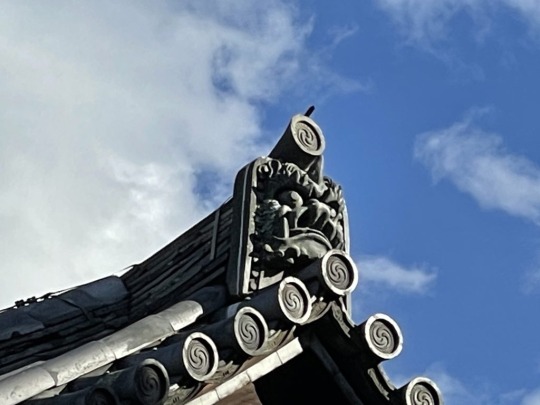
Photo taken from here: https://narashikanko.or.jp/naratime/plan/2023a0086-2
I’d be remissed if I didn’t also mention a semi-viral Japanese dish attributed to Shimonoseki in Yamaguchi Prefecture, 瓦そば (kawara soba). It consists of soba noodles cooked with matcha and served on a Japanese roof tile. It’s really cool!
It is said that the dish was inspired by a legend that soldiers in the Satsuma army ate food off roof tiles while surrounding Kumamoto Castle during the Satsuma Rebellion in 1877. But the origin of the dish itself is the Kawara Onsen in Shimonoseki. Don’t you wanna try it?

Photo is from this webpage: https://yamaguchi-tourism.jp/feature/kawarasoba
I also used this page as a source for kawara soba!
#japan#japanese#language#langblr#studying#studyblr#japanese studyblr#japanese langblr#japanese food#japanese culture#history
13 notes
·
View notes
Photo

Japanese Period Timeline Infographics
Did a simple timeline. It’s hard to summarise each period with just a few words. Hope you like it! 🤓
Pop Culture Trivias:
Ghost of Tsushima is based on the Mongol Invasion of Japan which took place in Kamakura Period where the descendant of Hojo Masako (wife of Minamoto no Yoritomo, the first Shogun of Japan), Hojo Tokimune led the defense.
47 Ronin starring Keanu Reeves, is based on the actual event of 47 loyal Ronin taking up arms to avenge their lord, that took place in Edo Period under the rule of the Tokugawa Shogunate.
The Last Samurai starring Tom Cruise, is based on the Satsuma Rebellion that took place in Meiji Period where Saigo Takamori (Ken Watanbe’s character is based on) led the last Samurai war against the modernised Imperials.
Rurouni Kenshin takes place during Meiji Period where he served the Imperial while his “rival”, Saito Hajime served the Shogunate before he became an Imperial Officer, which is why Saito “dislike” Kenshin in the beginning.
#japan#infographic#japanese timeline#japanese periods#japanese infographic#japanese illustration#japanese art#japanese history#japanese culture#nara period#heian period#kamakura period#muromachi period#azuhi momoyama period#edo period#meiji period#taisho period#showa period#heisei period#reiwa period#samurai#kamakura#ghost of tsushima#the last samurai#47 ronin#satsuma rebellion#rurouni kenshin#saito hajime#hojo masako#minamoto no yoritomo
179 notes
·
View notes
Text
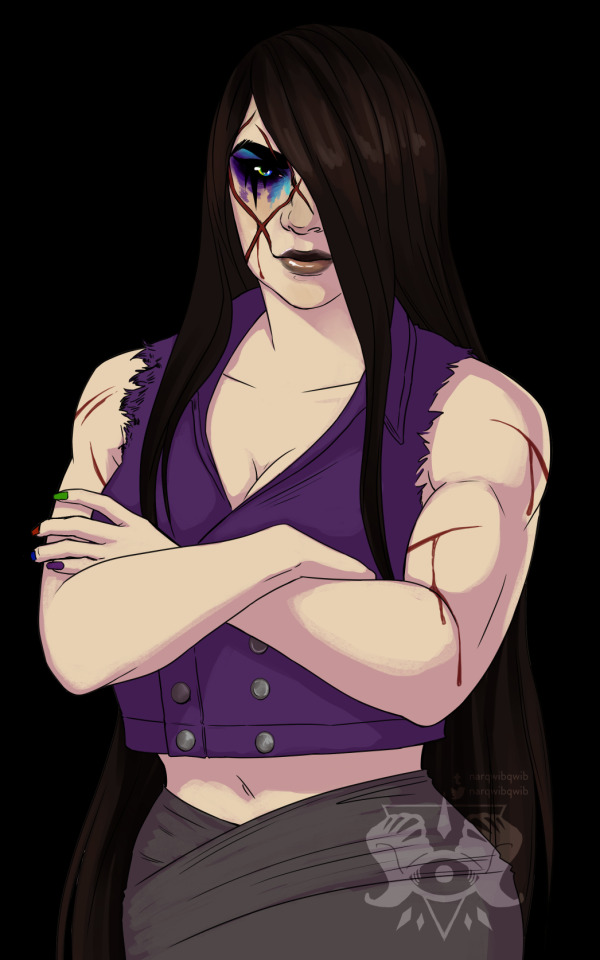
The Broken Sun
The Court: Ai Hoshino
Part 2 of a series of portraits of the members of the highest rank of kindred in my homebrew cult.
Embraced in 1877, Ai (they/them) is a former Onna-musha and Hunter that left Japan following their embrace during the Satsuma Rebellion. Now, they're only part of the Broken Sun for one reason - to hunt their biggest prey yet.
#vtm#vampire#vampire the masquerade#malkavian#artists on tumblr#my art#own art#chronicle: new orleans by night
45 notes
·
View notes
Text
Hi, I wrote something original
This is a pretty personal piece but I wanted to share it with my friends and mutuals on here.
The fantastical story of my cowardly great-great grandfather and how he refused to die.
Tachibana, a samurai of the failed Satsuma Rebellion, is ordered by the emperor to kill himself. He refuses and flees to a small fishing village where he meets Chiyo, a pearl diver who would like absolutely nothing to do with him.
A narrative deliberately warped by modern parlance as the truth wears away through time--a retelling of a retelling of the stories that my grandmother never finished.
Dark comedy, obvious suicide mentions (sepukku), deliberate anachronisms, and a dive into the historical reality of Japan facing cultural upheaval through western contact.
#writing#original writing#writeblr#historical fiction#screenplay#i haven't fully formatted it like a screenplay so it is very much still in a weird hybrid mode#i have some other stories on my wattpad but this is the one that i care the most about
27 notes
·
View notes
Text
i really pity the localization team behind Bravely Default. i'm not talking about the bravo bikini thing, or the aging up of the characters, those are topics that were broached in 2012. i'm talking about attempting to capture the energy of the many, many move names in a game that was designed for a Japanese audience.
like, the Arcanist moves are all named with a single Kanji. The move that inflicts doom is 屍, Shikabane, and this was translated literally as Corpse. The move that instakills any sleeping unit is 昏, Tasogare, and it is also translated literally as Twilight. the passive that increases magic power if the user's MP stat ends in 0 is 零, Rei, which is translated directly as Zero. while i can't deny that these are, in fact, what the words translate to, i can't help but feel like something was lost in translation, particularly the conciseness of writing everything with a single character.
Swordmaster has the opposite problem. this job's skill names are all Japanese proverbs or other turns of phrase. The first skill you get with it is 海老で鯛を釣る, Ebi de Tai wo Tsuru, which literally translates to "To catch a sea bream with a shrimp." It's a metaphor for making a small investment and getting big returns, which is a decent name for a skill where you wait to get attacked at half damage before countering at double damage. But the problem is twofold. One is that there's not a great English equivalent. Like the Bravely wiki says "Something for Nothing" could also work as a translation, but that leads to the second problem: You can't fit an entire English sentence in the confines of a command menu. English text just takes up more space than Japanese does, as we saw earlier with Arcanist having a four-syllable word written with one character. So how did they localize this command? Well, it's called Nothing Ventured. They tried to find equivalent versions of each. So we get move names like Squeaky Wheel and Before Swine, which to me read awkward as hell and barely feel like they match with what their skills do at all? Like one lowers enemy BP and another is a magical counterattack? Probably the most nightmare thing to translate is the final skill for this job, 薩摩守, Satsuma no Kami, literally The Governor of Satsuma. It removes MP cost for two turns. I'm sure that makes sense if you know Japanese history and about the Satsuma Rebellion, but it's too long for a skills menu and also uncommon knowledge in America. So the command was renamed to Free Lunch.
Another thing lost in translating every skill to English is the fact that, well, some skills were named in English to begin with. Specifically in Katakana, Japanese's transcription system for non-Japanese words. If I were to make a guess as to why Sky Knight's skills like Crescent Moon and Genocide (translated to Crescent Moon and Decimate respectively) were in English to begin with, I'd wager it's because English is a really easy way to sound cool to a Japanese audience. Merchant skills like Acquisition (translated as Payoff), Ripoff (translated as Salesman), and Speculate (kept as is), on the other hand, were probably that way because Merchant is, you know, the capitalist job, and it's hard to get more capitalist than the English-speaking world. But the problem is that the choice to have these skills be English words is lost when, for the localization, every skill has to be written in English.
I can talk about how a lot of these localization choices kind of water down the appeal a lot of these moves had in the original Japanese, but I want to stress here that being the translator on a game that is unapologetically by and for a Japanese audience is an unenviable task. It's something I've been thinking a lot about as I get into my own localization efforts, even though a whole Japanese game is obviously a lot more difficult to localize than a short Toki Pona one-shot fic. But it's really interesting, and I hope I've managed to convince somebody reading this of that too.
14 notes
·
View notes
Text

Whipmaster: Ballad of Murder (1970).
Ryotatsu (Bunta Sugawara), the blind whip-wielding nemesis of Shinkai, hero of the Wicked Priest film series, gets his own solo film outing this time.
Ryotatsu comes upon a blind boy, Rintaro, who is abandoned at a temple by his mother. Feeling sympathy for the boy, Ryotatsu takes Rintaro on the road to search for the mother. During this time, Ryotatsu teaches Rintaro how to live and function with his blindness.
They meet assorted unsavory types during their travels, including yakuza, corrupt army officials, and other no-goodniks, all with the Satsuma Rebellion of 1877 in the background. There's plenty of blood and action when Ryotatsu gets riles up, as is to be expected from any film in this series.
Ryotatsu is portrayed in a more sympathetic and heroic light as opposed to how he normally appears in Shinkai's adventures. Bunta Sugawara does his usual superb job in the role, especially as he's given so much more to do this time around.
Whipmaster was released between Wicked Priest 4: The Killer Priest Comes Back (1970) and Wicked Priest 5: Breaking the Commandments (1971). And where is Shinkai during all of this? I suppose he's on vacation, but Shinkai actor Tomisaburo Wakayama was not. He plays a doctor who may be able to cure Rintaro's blindness. It's a minor role, but Wakayama-san still manages to snag a prominent spot on the poster (that's him in the Santa Claus wig and beard).
13 notes
·
View notes